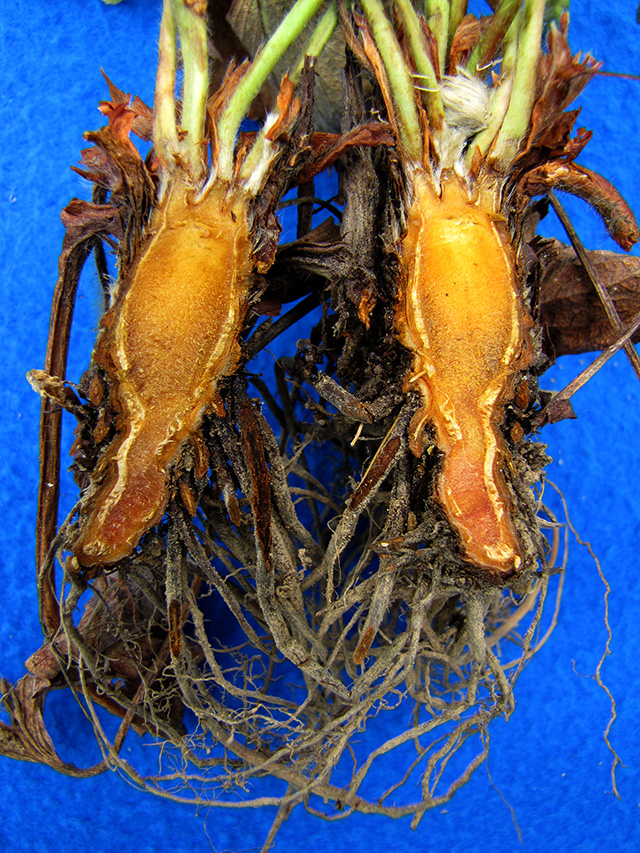Managing root rots can be essential for successful production of strawberry in the northeastern U.S. These diseases not only kill plants, but most of these pathogens can survive in soil for at least 10 years. Thus poor management in previous crops can affect future production on a farm. Prevention is key. Cultural practices starting at planting are also considered key to management. These include selecting resistant varieties and avoiding sites with favorable conditions (especially wet soil) or where root rot diseases have occurred before. There are conventional fungicides and biofungicides labeled for root rot diseases that can be integrated into a cultural practice-based program.
Plants affected by red stele are stunted and eventually die. Although not very common, the leaves on infected plants can be small and have a bluish discoloration. The root system is also small and dark. The diagnostic symptom of this disease is brick-red discoloration of the center (stele) of roots, which can be seen by cutting the root in half lengthwise (third image below). This tissue is almost white in a healthy plant and in plants with black root rot. The red stele is also often evident at the tips of roots where the outer tissue has rotted away (second image below). The pathogen, Phytophthora fragariae var. fragariae, produces spores that can survive at least 20 years in soil. This pathogen exists as races, some of which can overcome resistance in some strawberry varieties.
To manage red stele, select a field with good draining soils (avoid heavy, wet soils), where root rots have not occurred in previous strawberry crops. Rotation is most effective used as a preventive strategy, rather than as a means to manage diseases after they have become a problem, because the red stele pathogen produces spores that enable it to survive many years in soil. Minimize soil compaction. Increase soil tilth by incorporating organic matter such as straw from grain crops. Subsoil and use other practices to improve drainage. Minimize the opportunity for pathogens to be moved to new plantings from contaminated fields in soil on equipment, boots, or in water runoff. Plant on raised beds. Select resistant varieties. Varieties resistant to red stele and also Verticillium wilt include Earliglow, Delite, Guardian*, Midway, Redchief*, Sparkle, Surecrop*, and Sunrise (*also resistant to leaf spot and scorch). Other varieties resistant to red stele include Allstar, Mohawk, Northeaster, Tribute, and Tristar. Purchase certified plants from a reputable nursery. Before planting, inspect plants to ensure the root system is a healthy white color. Infected planting stock is a primary source of the red stele pathogen for new sites. Do not use plants that have symptoms. However, note that young plants can be infected but not display symptoms. Inspect plants routinely after planting. When dying plants are found, determine the cause and remove the plants if the cause is a root rot.
Fungicides are an additional tool for managing root rots in commercial crops. Mefenoxam, which is in the formulated product Ridomil Gold SL, is labeled for red stele. Apply as a banded spray to soil or through drip up to 3 times starting at transplanting or after ground thaws before first bloom. Pathogen strains resistant to mefenoxam have been found where this fungicide has been used for several years thus it is recommended to alternate with other products rather than apply 3 times. Aliette and phosphorous acid fungicides (K-Phite, ProPhyt, Phostrol, etc.) are also labeled for red stele. These can be applied as root dip, through drip, and to foliage. The biofungicides Actinovate and Double Nickel can be applied to soil at planting and through drip. They are approved for organic production. Soil fumigation can be effective for Verticillium wilt, but it is not effective for red stele.
Please Note: The specific directions on pesticide labels must be adhered to — they supersede these recommendations if there is a conflict. Any reference to commercial products, trade or brand names is for information only; no endorsement is intended. For up-to-date information on labeled fungicides see Cornell Pest Management Guidelines for Berry Crops.
Updated April 2017.






